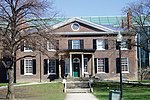OCAD University
1876 establishments in OntarioArt museums and galleries in OntarioArt schools in CanadaEducational institutions established in 1876Museums in Toronto ... and 5 more
OCAD UniversityUniversities and colleges in TorontoUniversities in OntarioUse Canadian English from September 2013Will Alsop buildings

Ontario College of Art & Design University (French: Université de l'École d'art et de design de l'Ontario), commonly known as OCAD University ( OH-kad), is a public university of art and design located in Toronto, Ontario, Canada. The main campus is adjacent to the Art Gallery of Ontario, within the Grange Park neighbourhood. The school is Canada's largest and oldest educational institution for art and design. OCAD U offers courses through the Faculties of Art, Design, Liberal Arts and Sciences, and alternative programs. The enabling legislation is the Ontario College of Art and Design University Act, 2002 (previously the Ontario College of Art & Design Act).
Excerpt from the Wikipedia article OCAD University (License: CC BY-SA 3.0, Authors, Images).OCAD University
McCaul Street, Toronto
Geographical coordinates (GPS) Address Website Nearby Places Show on map
Geographical coordinates (GPS)
| Latitude | Longitude |
|---|---|
| N 43.653055555556 ° | E -79.391194444444 ° |
Address
Main Building
McCaul Street 100
M5T 1W1 Toronto
Ontario, Canada
Open on Google Maps








